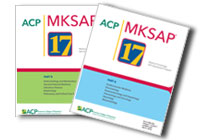 MKSAP has been trusted by internists since 1967 as the best resource for updating knowledge. MKSAP 17, available in Complete, Digital, and Print packages, consists of 11 comprehensive text chapters with related multiple-choice questions. You'll find 1,200 completely new questions to help you identify learning gaps, stay current, and gain the knowledge you need to provide the best possible patient care. MKSAP 17's original and high-quality questions evolve out of case studies and patient scenarios based on the latest evidence.
MKSAP has been trusted by internists since 1967 as the best resource for updating knowledge. MKSAP 17, available in Complete, Digital, and Print packages, consists of 11 comprehensive text chapters with related multiple-choice questions. You'll find 1,200 completely new questions to help you identify learning gaps, stay current, and gain the knowledge you need to provide the best possible patient care. MKSAP 17's original and high-quality questions evolve out of case studies and patient scenarios based on the latest evidence.
For more information on MKSAP 17, or to order your copy, visit mksap17.acponline.org.
MKSAP 17 Q & A
A 43-year-old woman is evaluated for acute-onset vertigo of 3 days' duration. She reports that severe vertigo accompanied by nausea and vomiting began abruptly and has been persistent. There are no maneuvers that accentuate or totally relieve her symptoms, and the severity of the vertigo prevents her from conducting her usual activities at work and home. She prefers to lie in bed with her eyes closed. She has had neither head trauma nor headaches and reports no motor weakness, numbness, tingling, otalgia, dysarthria, diplopia, hearing loss, tinnitus, fevers, or chills. Ten days ago, she had an upper respiratory tract infection. Medical history is otherwise unremarkable, and she takes no medications.
On physical examination, the patient is afebrile, blood pressure is 135/80 mm Hg, pulse rate is 98/min, and respiration rate is 14/min. BMI is 22. She appears uncomfortable and is lying down on the examination table with her eyes closed. She is unable to walk because of the vertigo. Hearing is normal. Pupils are equal, round, and reactive to light. Funduscopic examination reveals normal discs and vasculature. The remainder of the general medical examination is normal. On neurologic examination, finger-to-nose, rapid alternating movements, and heel-to-knee-to-shin tests are normal. The Dix-Hallpike maneuver evokes mixed upbeat-torsional nystagmus after 6 seconds that lasts for about 30 seconds; she then becomes very symptomatic and vomits. The remainder of the neurologic examination is normal.
Which of the following is the most likely diagnosis?
A: Benign paroxysmal positional vertigo
B: Brainstem infarction
C: Labyrinthitis
D: Vestibular neuronitis
Back to the July 2018 issue of ACP International

